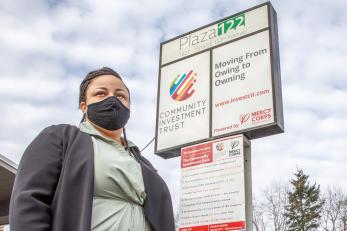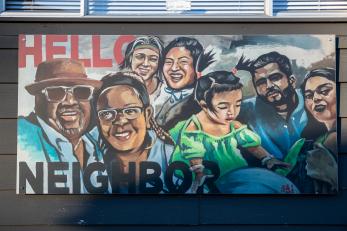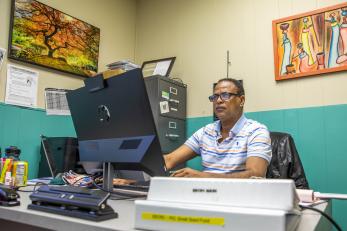Reimagining real estate investments to close the racial wealth gap

Jennifer Breedlove was born and raised in Portland, Oregon, where four generations of her family have lived since the 1940’s. They lived alongside other Black families in Northeast Portland, an area notorious for discriminatory redlining. For decades, Jennifer’s paternal great grandparents, grandparents, and parents made homes in some of the city’s historically Black neighbourhoods until they were driven out by gentrification—forcing Jennifer into a brief period of homelessness when she was just 14 years old.
Jennifer and her family’s story isn’t unique. In a country ruled by white-dominant power structures from its inception, racist policies and practices across government and the private sector have shaped a financial system that severely disadvantages people of colour – particularly Black and Brown people. According to the Institute for Policy Studies, today’s median Latinx family owns just 4% of the wealth a median white family does. For Black families, that number drops to 2%.
There are many causes behind how the racial wealth gap has grown so wide and real estate is the biggest factor. In the U.S. financial system, investing in real estate is the most effective way to generate wealth. Racist policies have long shut people of colour out of this opportunity, with home ownership furthest out of reach due to barriers ranging from historic redlining to displacement driven by gentrification. Because systemic racism prevents communities of colour from investing where they live, they are at much higher risk for displacement, which in turn exacerbates poverty and drives down BIPOC communities’ social capital, civic engagement, and sense of belonging.
Jennifer, who is now a mother of four and working to ensure a better life for her family, is pushing against institutional racism that has long created barriers for communities of colour to invest in real estate through the Community Investment Trust (CIT), a Mercy Corps programme.
The Community Investment Trust is a first-of-its-kind real estate investing model—closing the racial wealth gap by harnessing the systems that created it. With the Portland pilot, Jennifer joined her community in taking Mercy Corps’ “Moving from Owing to Owning” class, which aims to help residents in communities of colour and low-income areas begin seeing themselves as investors. The residents are offered the opportunity to invest in Plaza 122, a commercial-retail building in their neighbourhood that had been purchased by CIT on behalf of the neighbourhood investors. Residents can invest any amount between $10-$100, and their investments would not dip below their initial amount because of an agreement with the bank which removes the inherent risk of losing money. Residents have the flexibility to take out their investments at any time if they need access to their funds.
Unlike other financial education programmes, CIT immediately offers an opportunity toward building wealth. Since Jennifer completed the course and began investing, she has seen other cohorts complete the CIT programme. “It gives you a sense of pride, it gives you a sense of hope,” Jennifer said. “I’m able to be a part of my community at a larger level. It’s not just me that owns this. It’s other people like me or not like me who said we’re putting our money together now to own something together and build some type of wealth from it.”

Jennifer, who had worked at a bank for 15 years, began investing with CIT in 2018 and one year later she went on to facilitate the same classes that coached her into being a part owner of Plaza 122. “What motivated me to participate in the Community Investment Trust was the fact that it was something that was accessible to me, something that I could afford,” Jennifer said. “[It was] something that just made me feel like I was doing something with my community.” Based on the success of the resident investors and the demand from community groups to bring this model to their own cities, Mercy Corps is looking to expand the programme across the United States.
Both long-time Portland residents and recent arrivals, like immigrant communities, have an anchor in their neighbourhoods by investing with CIT. Yonas Kassie, an immigrant from Ethiopia, is not only a CIT investor but he’s also a tenant at Plaza 122. He arrived in the U.S. a decade ago and moved to Oregon five years ago, following his daughter who came to the state for university. For a time, he worked as a healthcare interpreter and became intimately aware of the challenges his community faces with moving to a new culture where they are unfamiliar with how to access resources. Yonas is currently the director of the Ethiopian Eritrean Cultural Resource Centre, a non-profit organisation that serves new immigrants and refugees. At Plaza 122, Yonas sees himself reflected by others who share the same values and dreams of building a better life in their own neighbourhood. “For me, it's like my second home,” Yonas said.

By building wealth where they live, immigrants have a tangible space to point and say they’ve invested in their own neighbourhood no matter how new they are to the area. “There is a feeling of belonging as to be part of the community, to be part of the city of Portland. Their city.” Yonas said. CIT’s unique approach pays dividends in the community by stabilising neighbourhoods, spurring improvements in social conditions, and strengthening civic engagement. 68% of investors in the Portland project report that they engaged in local activism and voted for the first time.

From Jennifer’s involvement as a participant investor to becoming a facilitator, she’s seen the impact of how one’s mindset can change by receiving an opportunity to invest. “It has opened the door for motivation and confidence to be able to have conversations with my neighbours because there is something that we reach or attain together,” Jennifer said. Through her work with CIT, Jennifer was inspired to start her own business more than a year ago. As a consultant, she works primarily with community organisations to reach underserved populations and helps BIPOC-owned small businesses take their operations to the next level. She taps into what she learned along the way to help underserved people and organisations gain access and resources—building wealth, building community.


